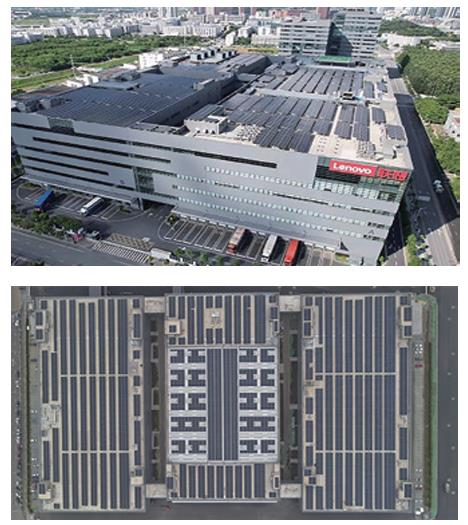Powering A Sustainable Future: Lenovo's Energy Targets And Renewable Solutions Drive Emissions Reduction And Efficiency
Under the EMS, energy-related targets are set annually. Since decreased energy use or increased renewable energy use impacts emissions, these energy-related targets are related to Lenovo's Scope 1 and 2 emissions reduction targets and similar actions are taken to achieve all three types of targets. For Lenovo's specific energy targets and its performance against them see Section 8.0.
By FY 2025/26, 90% of our global operations' electricity will be obtained from renewable sources. 2
Energy consumption also occurs throughout Lenovo's value chain. Energy is used by Lenovo's suppliers and its supply chain is encouraged to develop energy targets, use renewable energy, and report energy usage. Customers also use energy to power products and Lenovo has set targets to improve energy efficiency in many of its products.
For more information, see Section 9.0 for Lenovo's energy-related KPIs.
Renewable energy
Lenovo's renewable energy installations help to reduce Scope 2 emissions at its facilities. In July 2023, Lenovo enabled additional 3 MW solar electric at a factory in Hefei, China, increasing this location's total solar generation capacity to 10.1 MW. Moreover, the LSSC site in Shenzhen, China, and TJSC site in Tianjin, China, added new 2.3 MW and 4.02 MW solar installations, respectively, in FY2023/24. Lenovo's total solar generation capacity increased 48% compared to last fiscal year.
In addition to the 25.12 MW of solar electric that are currently operational, Lenovo continues to investigate additional opportunities for solar installations in China and other locations including Brazil and Mexico.
In addition to onsite solar generation capacity, Lenovo is proactively looking for opportunities for sourcing renewable electricity directly from utility suppliers. The TJSC campus in Tianjin, China, has signed a purchase agreement with a local utility supplier to provide 100 percent renewable electricity for its manufacturing and distribution area starting in January 2024. The Green Electricity Certificates documenting this renewable electricity are provided semiannually based on actual electricity consumption.
Where the use of onsite renewable energy sources is not technically or economically feasible, Lenovo chooses to purchase Renewable Energy Credits (REC), International Renewable Energy Credits (I-REC), Guarantees of Origin (GO), and Non-fossil certificates (NFCs). In FY 2023/24, Lenovo purchased renewable commodities that supported 100 percent renewable energy projects consisting of wind and/or solar power in various parts of the world including Brazil, China, India, Japan, Europe, Mexico, and US. During FY2023/24, Lenovo expanded its renewable energy procurement for the first time to Japan.
Operational energy efficiency
Given that one of Lenovo's most significant environmental aspects is emissions associated with energy consumption, it has a goal to continually improve the energy efficiency of its operations. In FY 2023/24, Lenovo's initiatives to help reduce energy consumption included the following methods:
- Energy Conservation – Active Method:
- Installation of low-energy equipment (including LED lighting, smart lighting system, air compressor, air conditioning, and chillers)
Usage of air compressor heat recovery and reuse
Harmonic control technology application of power distribution network
Usage of High-efficiency power transformer
Employed digitalization, including multiple-level smart energy metering devices, Lenovo ESG Navigator, campus energy management platform, and carbon 3D visualization
- Installation of energy-efficient windows or low-emissivity windows
Adoption of energy-saving and environmentally conscious materials in new construction
Centralized design of power room
Architectural design with natural lighting (including dome design, adding lighting windows, and split-level floor design)
Dock leveler heat isolation improvement
- Various manufacturing sites, office locations in EMEA, and the Beijing headquarters location are ISO 50001:2018 certified
The new Tianjin manufacturing site's buildings 1 and 8, and the Beijing headquarters are LEED Gold certified
- Employee awareness training
Energy conservation promotion (emails and tip signs)
Environmental spotlight
In November 2023, Lenovo's Tianjin Smart Campus (TJSC) was completed and put into operation. TJSC has implemented a total of 90 carbon reduction measures in nine major fields, including architectural design, construction process, campus management, manufacturing process, logistics, canteen, data center, digitalization, and renewable energy.
Lenovo deployed the Lenovo ESG Navigator to support TJSC. This integrated solution replaces the traditional manual management of ESG metrics with a flexible, transparent, and highly automated approach as it captures data across the value chain.
Logistics
Logistics is an important part of Lenovo's global supply chain and a key component of Lenovo's plan to meet net-zero by 2050. Lenovo is decarbonizing its logistics by deploying innovative solutions including demand management, low carbon transport, low carbon fuel, consolidation and utilization, and external partnerships.
In FY 2023/24, the priorities of Lenovo's logistics included:
Demand management
- Lenovo is reducing transportation activity by using ultra-light pallets for its Intelligent Device Group's (IDG) business group's products.
Lenovo is directing shipments to Australia and locating fulfillment centers closer to its customers in Malaysia.
Low carbon transport
- Using rail and sea freight when feasible which are lower carbon transportation compared with road and air freight.
Lenovo progressed its transition from air freight to road and sea freight including using the roll-on/roll-off shipping which replaced more than 50 percent emergent air delivery in Asia Pacific, and more than 96 percent of total Infrastructure Solutions Group's (ISG) shipments are transported by road in North America and China.
Lenovo increased the usage of rail freight in China, Europe and Latin America, thus reducing carbon emissions and other air pollutants by avoid using diesel truck.
Low carbon fuel
- Air shipments contribute roughly 87 percent of Lenovo's logistics-related emissions, Lenovo aims to cut emissions by transitioning to sustainable aviation fuel (SAF), which is made of waste biomass such as used cooking oil (UCO). SAF causes around 80 percent less CO2 emissions per flight than conventional aviation fuel.
Lenovo expanded alternative fuel delivery in Brazil, China, Chile, Malaysia, Mexico, the Netherlands, Poland, Thailand, and the UK.
Consolidation and utilization
- Lenovo optimizes the trailer loading for each business unit and combines trailers where possible. In FY 2023/24, Lenovo improved container utilization of truck shipments in Hong Kong from 51% to 71% as well as co-loading goods between business groups' products for ocean freight.
External partnerships
- Lenovo is an active partner to industry-wide coalitions, sustainable logistics initiatives, government organizations and NGOs, such as Global Logistics Emission Council (GLEC), Smart Freight Centre China and US Environmental Protection Agency (EPA) SmartWay program.
Striving to further reduce emissions, Lenovo aims to ensure that all stakeholders make a difference. Lenovo updated its logistics KPI methodology to require logistics suppliers to share their carbon emissions data with Lenovo. Lenovo also works with suppliers to set goals to reduce emissions. In addition, Lenovo shares its logistics CO2 report with its customers to improve transparency and increase awareness.
Read more
2 May be accomplished through installation of onsite renewable energy generation, entry into power purchase agreements (PPA) with power providers and/or the purchase of renewable energy credits.

Legal Disclaimer:
MENAFN provides the
information “as is” without warranty of any kind. We do not accept
any responsibility or liability for the accuracy, content, images,
videos, licenses, completeness, legality, or reliability of the information
contained in this article. If you have any complaints or copyright
issues related to this article, kindly contact the provider above.
Most popular stories
Market Research

- Zebu Live 2025 Welcomes Coinbase, Solana, And Other Leaders Together For UK's Biggest Web3 Summit
- 0G Labs Launches Aristotle Mainnet With Largest Day-One Ecosystem For Decentralized AI
- Aster's Next Era Begins: Airdrop Points Stage 2 Live, TGE Countdown Begins
- Ethereum Based Meme Coin Pepeto Presale Past $6.6 Million As Exchange Demo Launches
- Industry Leader The5ers Expands Funding Programs To U.S. Traders
- LYS Labs Moves Beyond Data And Aims To Become The Operating System For Automated Global Finance






















Comments
No comment